6.03.2018
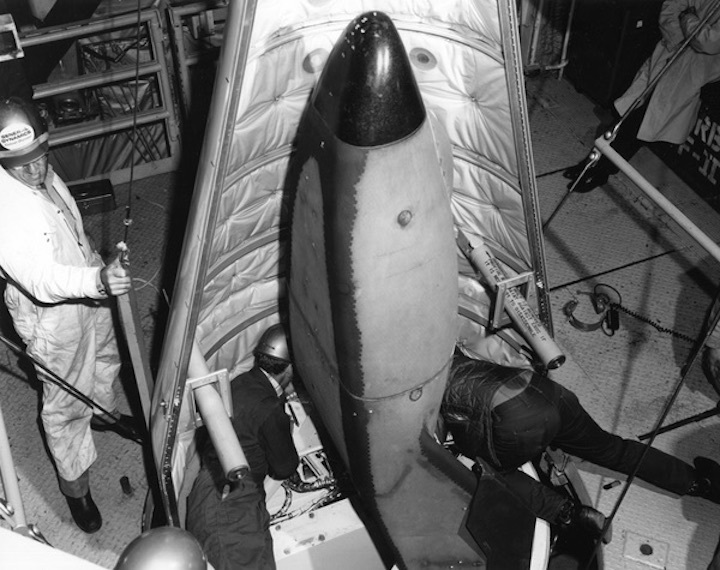 The X-23 PRIME test vehicle being prepared for launch. (credit: National Archives via Dwayne Day)
|
Movements of fire and shadow: The X-23 PRIME reentry vehicle and American satellite reconnaissance
On April 19, 1967, a spacecraft that looked somewhat like a fat, winged dart reentered the Earth’s atmosphere over the Pacific Ocean. As it dipped into the upper reaches of the ionosphere it began to glow and was surrounded by a fiery plasma. But rather than traveling in a straight line as most reentering spacecraft did, the glowing craft began banking at hypersonic speeds, finally slowing and deploying a parachute at a point more than 1,100 kilometers off its orbital path. A JC-130 aircraft grabbed its parachute lines high above the Pacific and the crew winched it inside. The experimental spacecraft, known as the X-23 PRIME, was not a classified project. According to the US Air Force, it was intended to test the ability of a spacecraft to travel crossrange from its entry orbit, something that many years later would be incorporated into the design of NASA’s space shuttle.
| PRIME was one of a whole suite of options that the NRO was then investigating to reduce the time to get imagery to decision-makers, but it was one of the most visible, hiding a research project for satellite reconnaissance in plain sight. |
But what was not public at the time was the fact that the X-23’s silent sponsor was an agency that normally operated in the shadows, and its very existence was then classified. The National Reconnaissance Office (NRO) operated the nation’s fleet of intelligence satellites, many of which returned images of Soviet military facilities on film contained in reentry vehicles that were recovered over the Pacific Ocean by the same C-130 aircraft involved in the PRIME recovery. Those reentry vehicles fell ballistically from orbit, which meant that they could fall anywhere within a sizeable reentry ellipse and thus had to be recovered over the ocean, far from where their exposed film would be processed and analyzed. The NRO was interested in reducing the time that it took to get the film from orbit to photo-analysts in Washington, DC, who would peer through microscopes at light tables and try to discern what was happening inside the Soviet Union. Vehicles such as PRIME could potentially make it possible to land that film inside the continental United States, something that intelligence officials considered doing ever since the early 1960s but had never committed to, due to technical and political limitations.
The connection between PRIME and the NRO is mentioned in a declassified letter written in 1965 by then NRO Director Brockway McMillan to Secretary of Defense Robert McNamara. McMillan referred to a task that McNamara had recently given him to “Propose a plan to develop the capability for instantaneous satellite reconnaissance with at least G[AMBIT] resolution for various uses (particularly in relation to Titan-III) such as monitoring the arms control agreements, tactical uses, etc.” PRIME was one of a whole suite of options that the NRO was then investigating to reduce the time to get imagery to decision-makers, but it was one of the most visible, hiding a research project for satellite reconnaissance in plain sight.
 The X-23 PRIME test vehicle being prepared for launch. (credit: National Archives via Dwayne Day)
|
From sky to eye
By the mid-1960s, the NRO was operating both the CORONA and GAMBIT reconnaissance satellites. GAMBIT-1 was a high-resolution satellite that was scheduled to be replaced by the upgraded GAMBIT-3 in 1966. GAMBIT-3 would launch atop a Titan rocket and may have prompted McNamara to ask McMillan what better systems were possible considering the increased payload capability of the even bigger Titan III then in development.
McMillan replied that he had a three-phase program underway: 1) improve existing systems; 2) incorporate the desired characteristics to the maximum practicable degree in the next generation of satellite systems, and 3) continue studies and hardware investigations looking toward a further generation.
McMillan’s memo included a tutorial on reconnaissance satellites and how they operated that was sort of a Satellite Reconnaissance 101 for those with the security clearances to read it. The amount of detail McMillan included implies that he was addressing an audience that was becoming increasingly exposed to the five-year-old capability to take photographs from space, but now wondering why they could not simply order photographs of specific targets and have them delivered within a relatively short period of time.
| The amount of detail McMillan included implies that he was addressing an audience that was becoming increasingly exposed to the five-year-old capability to take photographs from space, but now wondering why they could not simply order photographs of specific targets and have them delivered within a relatively short period of time. |
As McMillan explained, existing satellite systems had many limitations, including the fact that satellites and their rockets took a long time to prepare for flight. This was not only a problem for the hardware, but the software as well. The vehicles had to be programmed in advance, which was not easy to do for computer systems designed in the early 1960s. In order to reduce the time to order a photograph and deliver it, the NRO was working on a number of improvements to both the CORONA and GAMBIT satellites. These included improving the ability of the hardware to stand in ready condition, reducing the time required to prepare new orbits and camera programs, and decreasing the delay in configuring the hardware to match a desired orbit based upon new target requirements.
McMillan reported that there were also some additional near-term actions the NRO could take. One was to recover the satellite reentry vehicle in the recovery area northwest of Hawaii at night and on south-to-north passes, providing for earlier or more flexibly chosen recoveries. Another possible improvement was processing recovered film while in flight from the recovery area, which “attacks a significant source of delay in present operations,” McMillan explained. Finally, they could add alternate launch facilities or increase boost capabilities “to permit orbits more efficiently covering areas such as Cuba, the Soviet missile belt, etc.”
Of these developments, the NRO did improve programming and readiness for its satellites, although some of these improvements came with their own limitations. For instance, a CORONA satellite was prepared to hold at the T minus 24 hours mark for up to two weeks. But it could not be held at such a state permanently, and being ready to launch did not guarantee a launch would take place: as McMillan explained, equipment reliability still scrubbed many launches. Changing out trajectory programming for CORONA’s Thor rocket required physically disassembling part of the rocket to get at the internal guidance system.
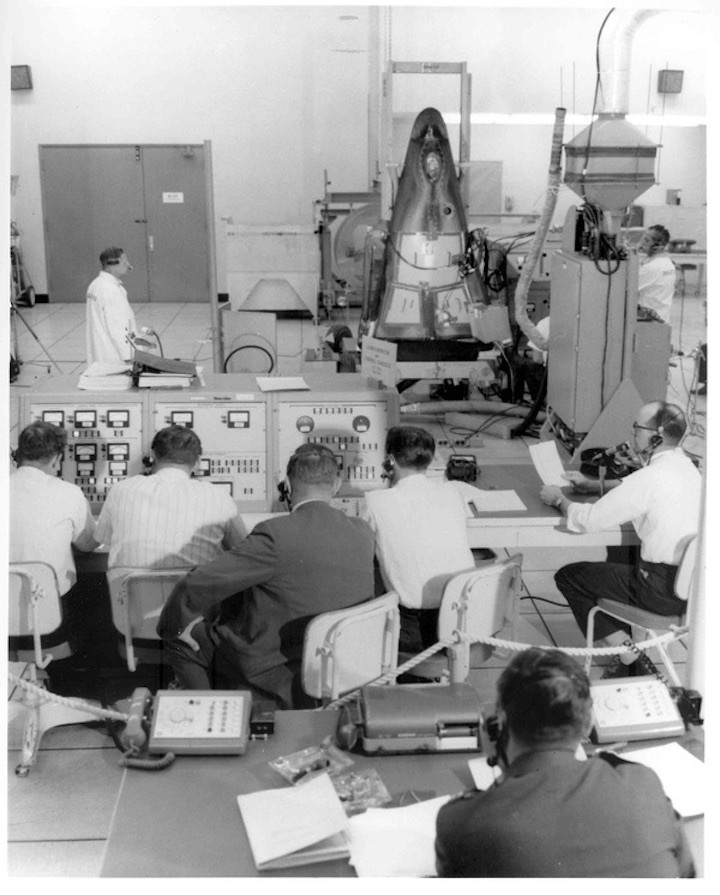 The X-23 PRIME test vehicle being prepared for launch. (credit: National Archives via Dwayne Day)
|
The NRO did not pursue the other options to operational capability, although it is unclear why. A single nighttime recovery of a CORONA vehicle was apparently successfully conducted, but there is no evidence that it was ever repeated. Given the importance of the satellite film, night recovery was probably too risky even if it saved time. The C-130 pilots also might have found it too difficult. South-to-north passes posed a risk that if the satellite overshot the recovery area it might come down in the Arctic, much closer to Soviet territory. The only possible alternative to launching from Vandenberg Air Force Base in California was launching from Florida, which did not offer much in the way of better orbits. Launch vehicles were improved over time, and the NRO considered the option of launching a CORONA on a more expensive Atlas rocket to expand its orbit options, but major launch vehicle upgrades were usually rejected except when they were required for entirely new satellites.
The system for developing exposed reconnaissance film in the back of a cargo aircraft while flying to Washington was also not made operational, although there are indications that the NRO started contracting for its development. There is no information about why the system was not completed, but the most likely explanation is that this was considered too risky. At the time, Eastman Kodak in Rochester, New York, handled reconnaissance film processing and the company’s engineers and technicians had earned a reputation as wizards capable of making subtle alterations in processing chemistry to extract the most information possible from the film. Eastman Kodak manufactured the film and the materials and chemicals they used were cutting edge technology. Trusting the delicate film processing to a group of airmen in a bouncing C-135 over the Pacific Ocean might have been vetoed by the nation’s senior intelligence advisors.
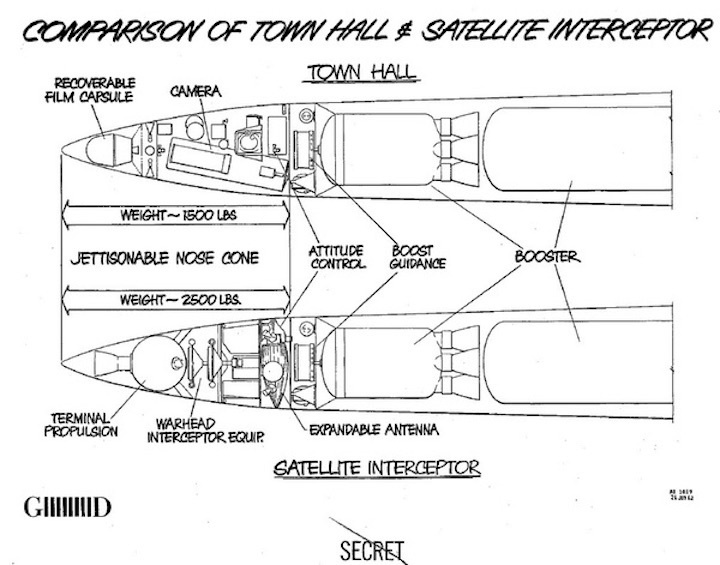 Throughout the 1960s the US Air Force and National Reconnaissance Office considered various proposals for air-launching satellite vehicles, including reconnaissance satellites. A 1962 proposal for launching a rocket from a B-58 Hustler bomber was never pursued. (credit: NRO)
|
Launching, and landing
McMillan listed several options for future vehicles that could reduce the response time. One option was air launching a spacecraft from a bomber or transport aircraft. McMillan explained to McNamara that the NRO had studied this launch technique several times because it allowed for flexibility in selection of launch sites and hence orbits. In 1962 General Dynamics undertook a study known as “Town Hall” that evaluated deploying a rocket from underneath a B-58 Hustler aircraft carrying either a satellite interceptor or a “covert reconnaissance satellite.” Another study looked at deploying a rocket out of the back of a C-130, and there were proposals to launch an orbital rocket off an A-12 OXCART aircraft at Mach 3. Air launch would also make it harder for the Soviet Union to detect a launch and track the satellite. The problem with all these proposals was that the available payload would not allow a spacecraft to carry a useful camera.
Another option was adding more fuel to a spacecraft to allow for orbit adjustments that could enable freer target selection and more recovery times and places. But the rules of orbital mechanics were not very flexible, and a spacecraft could not really change its orbit without a huge amount of fuel.
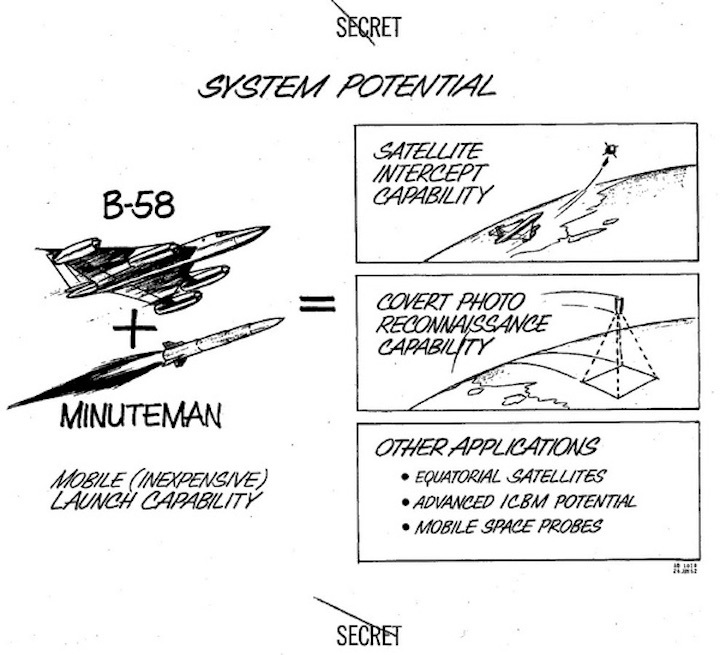 Throughout the 1960s the US Air Force and National Reconnaissance Office considered various proposals for air-launching satellite vehicles, including reconnaissance satellites. A 1962 proposal for launching a rocket from a B-58 Hustler bomber was never pursued. (credit: NRO)
|
| There was another option that the NRO was then considering: maneuverable reentry vehicles that could come down far off their orbital path, possibly enabling them to reenter over water and steer towards land. |
Three other options included a multiple recovery system, a land recovery system, and a maneuverable recovery system. The multiple recovery system was already in use with CORONA, and was an option for the GAMBIT-3, although it was not introduced until 1969. Land recovery was actually part of the original GAMBIT design in 1960 but was abandoned early in the program for several reasons. Program officials were concerned about a satellite vehicle shedding parts of its equipment while over North America. It would be bad—and entirely unwelcome—publicity if a parachute cover fell through the roof of somebody’s house in Colorado. Land recovery was never developed for any further film reconnaissance system.
There was another option that the NRO was then considering: maneuverable reentry vehicles that could come down far off their orbital path, possibly enabling them to reenter over water and steer towards land. McMillan noted that there were two types being studied at that time, one for a large payload and the other for a small payload. The latter was appropriate for a multiple recovery reconnaissance satellite. This latter project was known as START, and was then funded in the unclassified Air Force budget.
 The X-23 PRIME test vehicle being prepared for launch. (credit: National Archives via Dwayne Day)
|
From START to PRIME
In the late 1990s, former Air Force historian Richard Hallion wrote and edited “The Hypersonic Revolution,” the definitive history of the development of hypersonic vehicles, which included an extensive discussion of PRIME and its predecessors. Hallion explained that numerous test shapes had been studied for advanced reentry tests for many years before the Spacecraft Technology and Advanced Reentry Tests (START) program was formally named in 1964. According to Hallion, both Brockway McMillan and Assistant Secretary of the Air Force for Research and Development Alexander Flax were briefed on START in March 1964, after which Flax became a key proponent for the program.
The Air Force was testing maneuverable reentry vehicles to gain vital information on both hypersonic flight in general as well as specific vehicle shapes. There is no indication that the NRO actually funded the START program, but there was no reason for it to do so since the Air Force was able to fund the research program and the NRO would have ready access to the results. In fact, a declassified history of a 1970s-era NRO satellite program notes that, by the early 1970s, the NRO had sought to keep its budget lower by having certain unspecified projects funded outside the agency. This was apparently due to political reasons: to avoid making the secret NRO budget exceed a billion dollars, which some believed would attract unwanted attention.
The Air Force and its contractor Martin had settled on a specific shape named the SV-5 that they believed would best handle the high temperatures encountered during hypersonic flight through the atmosphere. A slight modification known as the SV-5D shape was used as the basis for what became known as the X-23 PRIME maneuvering reentry vehicle. The X-23 was a little over two meters long and one meter wide, with upturned wingtips and body flaps at the rear that would enable it to maneuver.
In October 1965, McMillan was replaced by Alexander Flax as Director of the NRO. In this role he continued the NRO’s support of the maneuverable reentry body test program.
 The X-23 PRIME test vehicle being prepared for launch. (credit: National Archives via Dwayne Day)
|
PRIME flies
The first flight took place on December 21, 1966, when PRIME was launched atop an Atlas rocket from Vandenberg Air Force Base. The vehicle reentered over the Pacific Ocean but the first test did not involve any maneuvering. At thirty kilometers altitude it deployed a ballute—an inflatable deceleration device—but failed to properly deploy its recovery parachute and fell into the water without being recovered.
| PRIME was a test vehicle, not a prototype for an operational maneuverable reentry vehicle, and despite the successful PRIME tests and the interest of the NRO leadership, the maneuverable reentry vehicle was not incorporated into any subsequent American reconnaissance satellite. |
Two more launches from Vandenberg followed. The second test took place on March 5, 1967 and this time the vehicle performed a 1,053-kilometer cross-range reentry, banking at hypersonic speeds with the assistance of body flaps at the rear of the vehicle. It properly deployed its parachute and was spotted by recovery aircraft. However, due to a post-deployment problem with the parachute system the vehicle could not be recovered in midair and the aircraft followed it down and reported its location as the X-23 PRIME vehicle landed in the water. The seas proved too rough and the vehicle sank before it could be picked up by a ship, but the test had proven that maneuverable hypersonic reentry vehicles were feasible.
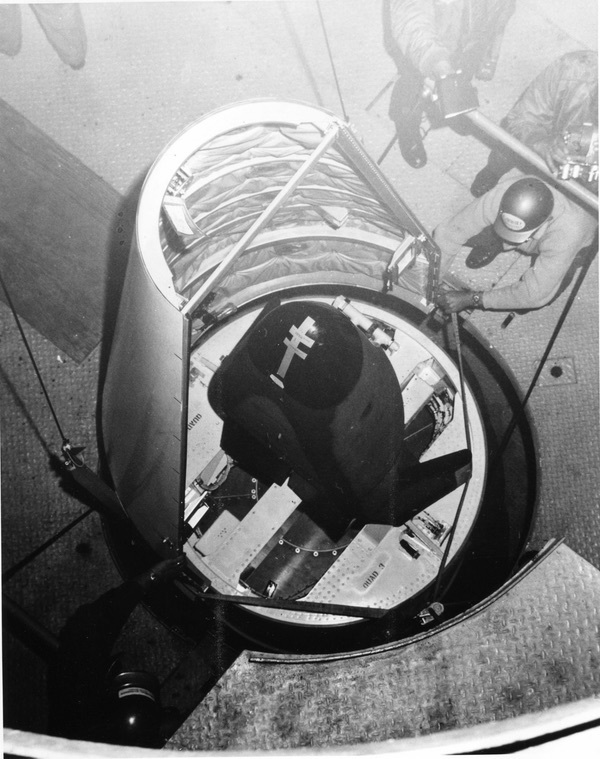 The X-23 PRIME test vehicle being prepared for launch. (credit: National Archives via Dwayne Day)
|
The third and final flight took place on April 19, 1967, and this time tested a 1,143-kilometer cross-range. The parachute system functioned perfectly and the vehicle was recovered by an aircraft. The X-23 team reported that the recovered vehicle was in excellent shape and could be reflown, but with all test objectives achieved there was no reason to conduct another flight. Today both the third and unflown fourth vehicle are on display at the National Museum of the United States Air Force.
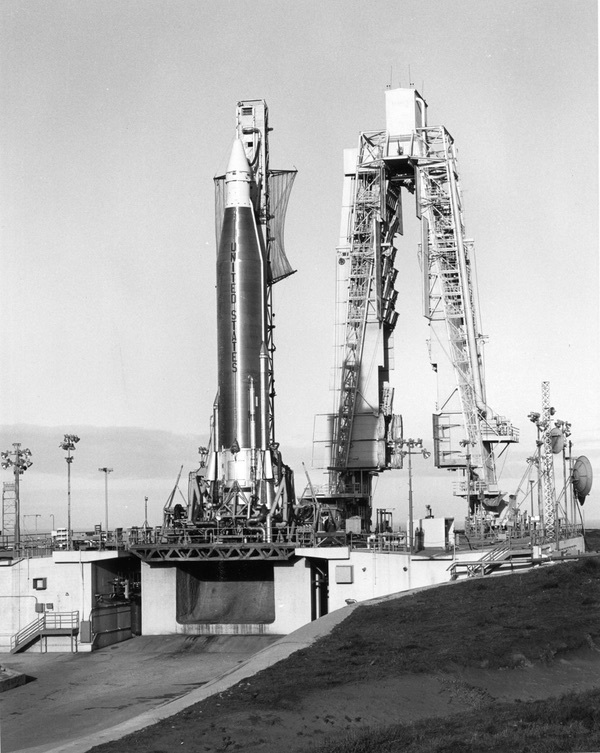 The X-23 PRIME test vehicle being prepared for launch. (credit: National Archives via Dwayne Day)
|
In a recent email, Hallion recalled that when he was doing his research for “The Hypersonic Revolution” in the 1990s he detected hints that PRIME may have been intended for a reconnaissance role, but satellite reconnaissance was still so highly classified that nothing was public. He also remembered seeing drawings of a PRIME derivative with a large spherical tank and maneuvering rocket on its back, “a propellant tank and kick-stage combo, that could have been used to do some degree of orbital maneuvering.” Hallion explained that the fourth PRIME vehicle differed from the earlier ones, being designed to be capable of either greater maneuverability or a steeper descent. He also suspected that the fourth vehicle was being reserved for an operational role, but “the rapid development of the satellite systems made the need for this one unnecessary.”
 Launch of the X-23 PRIME test vehicle. (credit: National Archives via Dwayne Day)
|
In his history, Hallion declared PRIME as an unqualified success and stated that it provided substantial data on various aspects of hypersonic flight, information that proved vital to the design of NASA’s space shuttle. But PRIME was a test vehicle, not a prototype for an operational maneuverable reentry vehicle, and despite the successful PRIME tests and the interest of the NRO leadership, the maneuverable reentry vehicle was not incorporated into any subsequent American reconnaissance satellite.
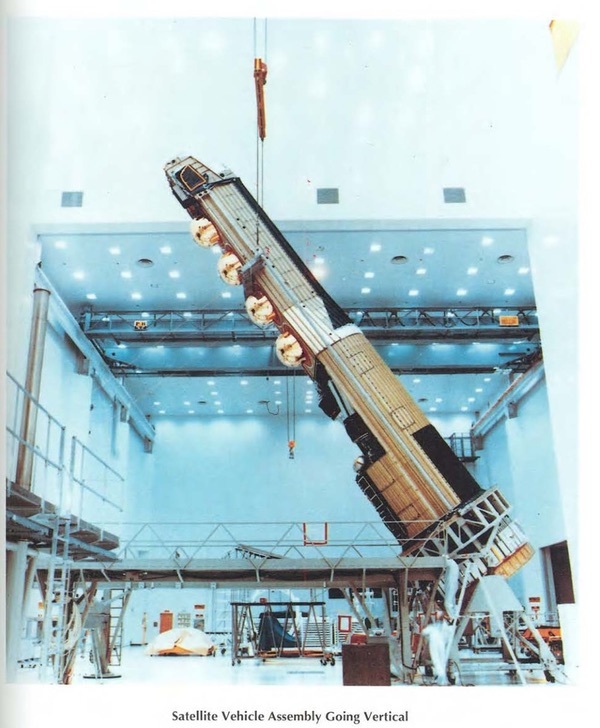 The bus-sized HEXAGON reconnaissance satellite carried four conventional kettle-shaped reentry vehicles for its film. The HEXAGON could have accommodated maneuverable reentry vehicles, but none were proposed. (credit: NRO)
|
Sticking with the proven technology
In 1971, the first schoolbus-sized HEXAGON reconnaissance satellite was launched into orbit atop a Titan III rocket. The front end, or forebody, of the spacecraft carried four large reentry vehicles, each about the size of a riding lawn mower and looking like a big soup kettle. The reentry vehicles were similar in shape to the ones used successfully for both the CORONA and GAMBIT programs, although significantly larger. They were manufactured by McDonnell rather than General Electric, which had supplied the reentry vehicles for CORONA and GAMBIT. The design for HEXAGON’s reentry vehicles was established by 1967, and because HEXAGON was a CIA program, and maneuverable reentry vehicles like PRIME had been studied by the Air Force, a “not invented here” attitude might have led CIA managers to not even consider the technology for their spacecraft. HEXAGON was certainly large enough to carry several reentry vehicles of the approximate size and shape of the X-23 PRIME, but the HEXAGON’s method of returning film, although sophisticated, was still entirely conventional.
| The Air Force’s X-23 PRIME research proved valuable for other applications, particularly the space shuttle program. But it was never used to bring back top-secret photos from space. |
To date there are no declassified records indicating why maneuverable reentry vehicles were not used in the American reconnaissance satellite program. However, the most probable reason is that the existing ballistic reentry vehicles worked and had taken considerable effort to perfect. Switching to a new vehicle and new operational approach—recovery over the continental United States instead of northwest of Hawaii—would have cost money, imposed risks, and required changes in procedures and equipment. If this approach was adopted for one spacecraft, such as the HEXAGON with its four large reentry vehicles, but not the smaller GAMBIT spacecraft which carried two, then the Air Force would have had to support recovery forces both in the continental US and in Hawaii, increasing costs.
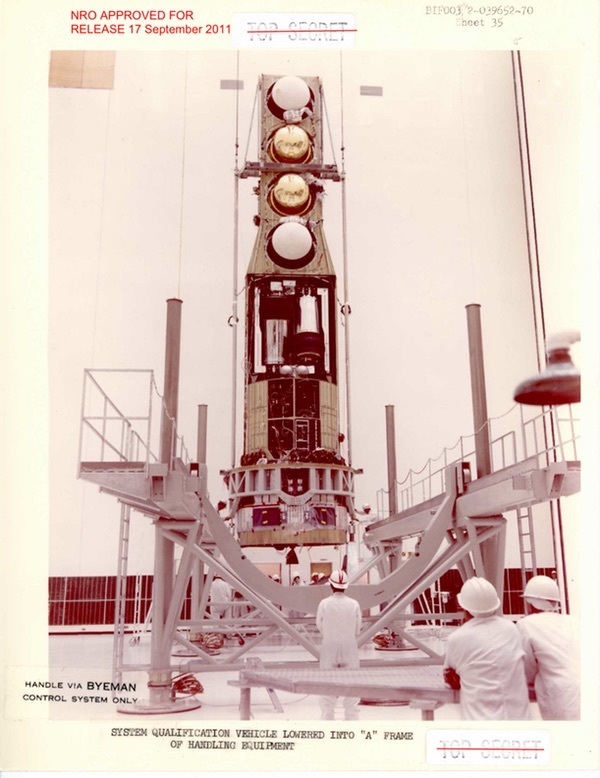 The bus-sized HEXAGON reconnaissance satellite carried four conventional kettle-shaped reentry vehicles for its film. The HEXAGON could have accommodated maneuverable reentry vehicles, but none were proposed. (credit: NRO)
|
The Air Force’s X-23 PRIME research proved valuable for other applications, particularly the space shuttle program. But it was never used to bring back top-secret photos from space. Then again, the Air Force’s currently operational X-37B spaceplane benefits from the research conducted by PRIME, and we still have no clue as to what it brings back to Earth inside its payload bay.
Quelle: The Space Review
